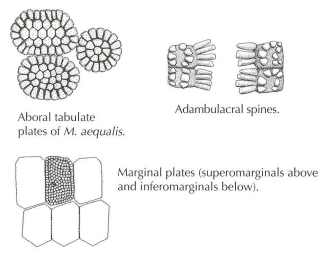Mediaster aequalis is a flat, broad-armed sea star with five arms up to 10 cm long. It is vermilion aborally and more orange orally, with red to flesh-coloured tube feet. The ratio of arm to disc is from 2.4 to 3.0. The aboral tabulate plates are hexagonal to round and bear up to 24 flat-topped, roundish central granules and up to 25 slightly longer peripheral granules. Two or three papulae occur between the plates, except in a triangular area in the interradial region where there are none. M. aequalis has 28 conspicuous superomarginals that are not bulging or separated from the inferomarginals by an obvious groove, as in Gephyreaster swifti. The inferomarginals are similar to the superomarginals, and there is a slight zigzag line between the two series. The oral interradial area is extensive, with oral intermediates nearly to tip of the arm, each one oval, with roundish groups of 2 or 3 central granules and 5 to 10 peripheral. The adambulacrals are squarish with 3 to 5 blunt prismatic furrow spinelets and two longitudinal series of 3 shorter blunt spines on the oral surface. The mouth plates have a marginal series of 5 to 7 prismatic spinelets, and 3 to 5 thicker prismatic suboral spinelets and granules on the outer part of the plate.
Characteristics
Similar SpeciesMediaster aequalis may be confused with Gephyreaster swifti or Pseudarchaster alascensis, but it differs mainly in the form and arrangement of the marginal plates. Compare the descriptions of marginal plates for the three specie
